Table of Contents
Discontinuous progress investigation
Published 02 February, 2015; last updated 08 March, 2021
We have collected cases of discontinuous technological progress to inform our understanding of whether artificial intelligence performance is likely to undergo such a discontinuity. This page details our investigation.
We know of ten events that produced a robust discontinuity in progress equivalent to more than a century at previous rates in at least one interesting metric and 53 events that produced smaller or less robust discontinuities.
Details
Motivations
We are interested in learning whether artificial intelligence is likely to see discontinuous progress in the lead-up to human-level capabilities, or to produce discontinuous change in any other socially important metrics (e.g. percent of global wealth possessed by a single entity, economic value of hardware). We are interested because we think this informs us about the plausibility of different future scenarios and about which research and other interventions are best now, and also because it is a source of disagreement, and so perhaps fruitful for resolution.1
We seek to answer this question by investigating the prevalence and nature of discontinuities in other technological progress trends. The prevalence can then act as a baseline for our expectations about AI, which can be updated with any further AI-specific evidence, including that which comes from looking at the nature of other discontinuities (for instance, whether they arise in circumstances that are predicted by the arguments that are made for predicting discontinuous progress in AI).
In particular, we want to know:
- How common are large discontinuities in metrics related to technological progress?
- Do any factors predict where such discontinuities will arise? (For instance, is it true that progress in a conceptual endeavor is more likely to proceed discontinuously? If there have been discontinuities in progress on a metric in the past, are further discontinuities more likely?)
As a secondary goal, we are interested in learning about the circumstances that have surrounded discontinuous technological change in the past, insofar as it may inform our expectations about the consequences of discontinuous progress in AI, should it happen.
Methods
Main article: methodology for discontinuous progress investigation.
To learn about the prevalence and nature of discontinuities in technological progress, we:
- Searched for potential examples of discontinuous progress (e.g. ‘Eli Whitney’s cotton gin’) via our own understanding, online search, and suggestions from others.2
- Chose specific metrics related to these potential examples (e.g. ‘cotton ginned per person per day’, ‘value of cotton ginned per cost’) and found historic data on progress on those metrics (usually in conjunction with choosing metrics, since metrics for which we can find data are much preferred). Some datasets we found already formed in one place, while others we collected ourselves from secondary sources.
- Defined a ‘rate of past progress’ throughout each historic dataset (e.g. if the trend is broadly flat then gets steeper, we decide whether to call this exponential progress, or two periods of linear growth.)
- Measured the discontinuity at each datapoint in each trend by comparing the progress at the point to the expected progress at that point based on the last datapoint and the rate of past progress (e.g. if the last datapoint five years ago was 600 units, and progress had been going at two units per year, and now a development took it to 800 units, we would calculate 800 units – 600 units = 200 units of progress = 100 years of progress in 5 years, for a 95 year discontinuity.)
- Noted any discontinuities of more than ten years (‘moderate discontinuities’), and more than one hundred years (‘large discontinuities’)
- Judged subjectively whether the discontinuity was a clear divergence from the past trend (i.e. the past trend was well-formed enough that the new point actually seemed well outside of plausible continuations of it).3
- Noted anything interesting about the circumstances of each discontinuity (e.g. the type of metric it was in, the events that appeared to lead to the discontinuity, the patterns of progress around it.)
Note that this is not an attempt to rigorously estimate the frequency of discontinuities in arbitrary trends, since we have not attempted to select arbitrary trends. We have instead selected trends we think might contain large discontinuities. Given this, it may be used as a loose upper bound on the frequency of discontinuities in similar technological trends.
It is likely that there are many minor errors in this collection of data and analysis, based on the rate at which we have found and corrected them, and the unreliability of sources used.
Definitions
Throughout, we use:
- Discontinuity: abrupt progress far above what one would have expected by extrapolation, measured in terms of how many years early the progress appeared relative to its expected date.
- Moderate discontinuity: 10-100 years of progress at previous rates occurred on one occasion
- Large discontinuity: at least 100 years of progress at previous rates occurred on one occasion
- Substantial discontinuity: a moderate or large discontinuity
- Robust discontinuity: a discontinuity judged to involve a clear divergence from the past trend
Summary figures
- We collected 21 case studies of potentially discontinuous technological progress (see Case studies below) and investigated 38 trends associated with them.
- 20 trends had a substantial discontinuity, and 15 had a large discontinuity.4
- We found 88 substantial discontinuities, 39 of them large.
- These discontinuities were produced by 63 distinct events
- Ten events produced robust large discontinuities in at least one metric.
Case studies
This is a list of areas of technological progress which we have tentatively determined to either involve discontinuous technological progress, or not. Note that we largely investigate cases that looked likely to be discontinuous.
Ship size
Main article: Historic trends in ship size
Trends for ship tonnage (builder’s old measurement) and ship displacement for Royal Navy first rate line-of-battle ships saw eleven and six discontinuities of between ten and one hundred years respectively during the period 1637-1876, if progress is treated as linear or exponential as usual. There is a hyperbolic extrapolation of progress such that neither measurement sees any discontinuities of more than ten years.
We do not have long term data for ship size in general, however the SS Great Eastern seems to have produced around 400 years of discontinuity in both tonnage (BOM) and displacement if we use Royal Navy ship of the line size as a proxy, and exponential progress is expected, or 11 or 13 in the hyperbolic trend.
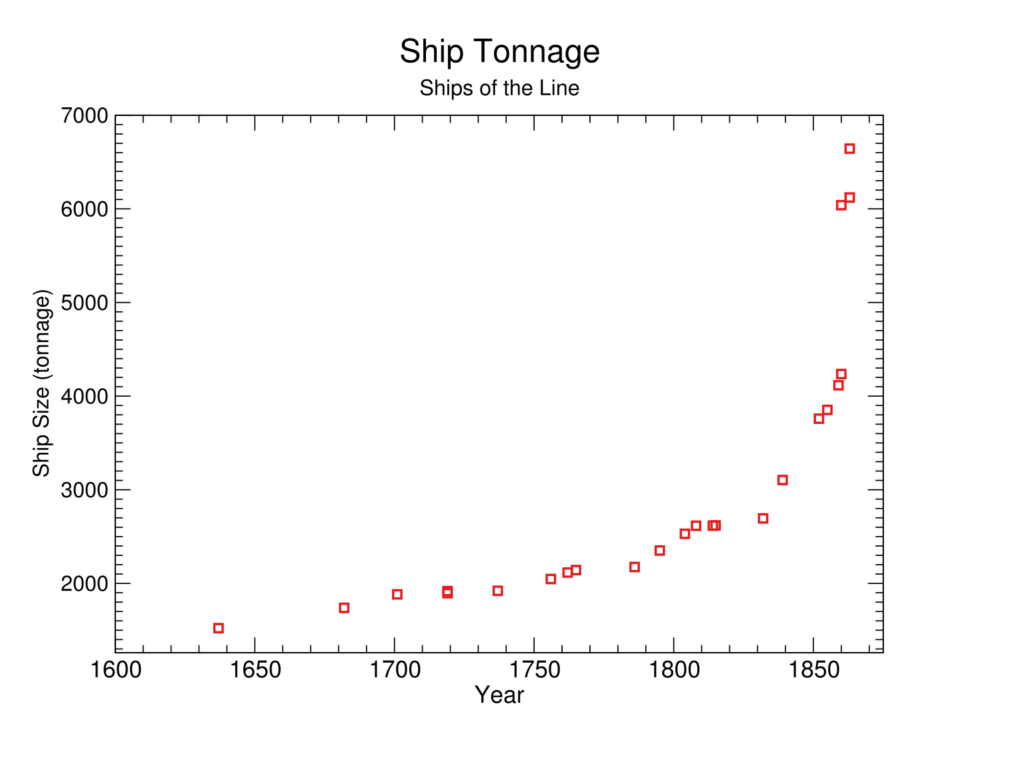
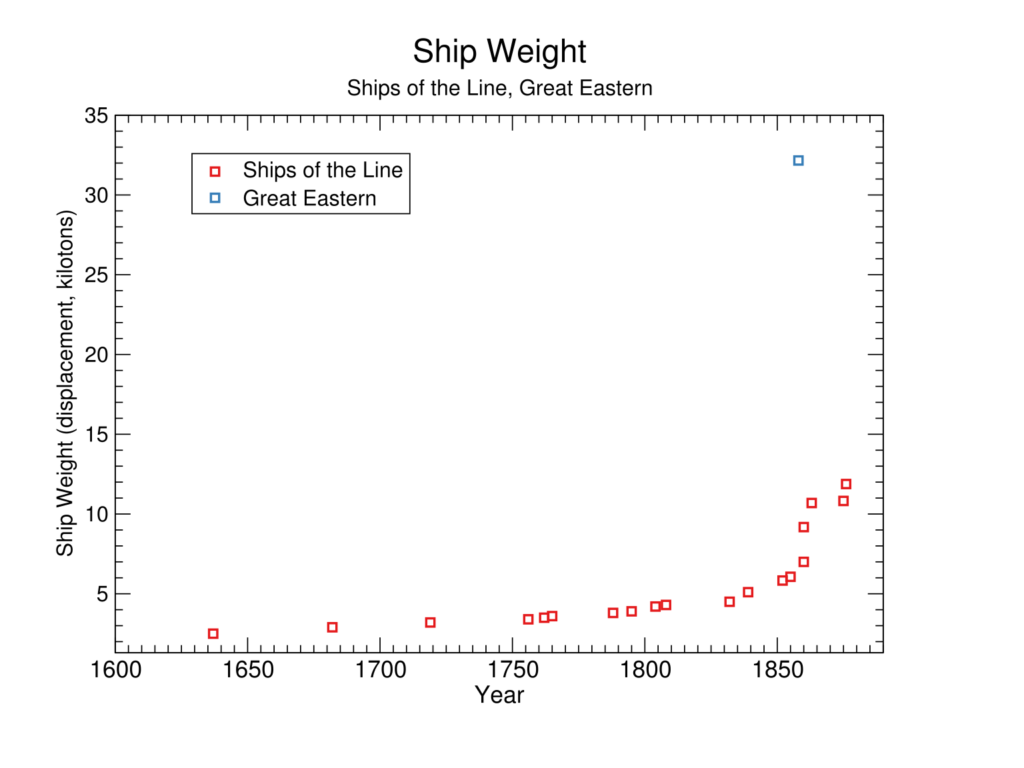
Image recognition
Main article: Effect of AlexNet on historic trends in image recognition
AlexNet did not represent a greater than 10-year discontinuity in fraction of images labeled incorrectly, or log or inverse of this error rate, relative to progress in the past two years of competition data.
Transatlantic passenger travel
Main article: Historic trends in transatlantic passenger travel
The speed of human travel across the Atlantic Ocean has seen at least seven discontinuities of more than ten years’ progress at past rates, two of which represented more than one hundred years’ progress at past rates: Columbus’ second journey, and the first non-stop transatlantic flight.
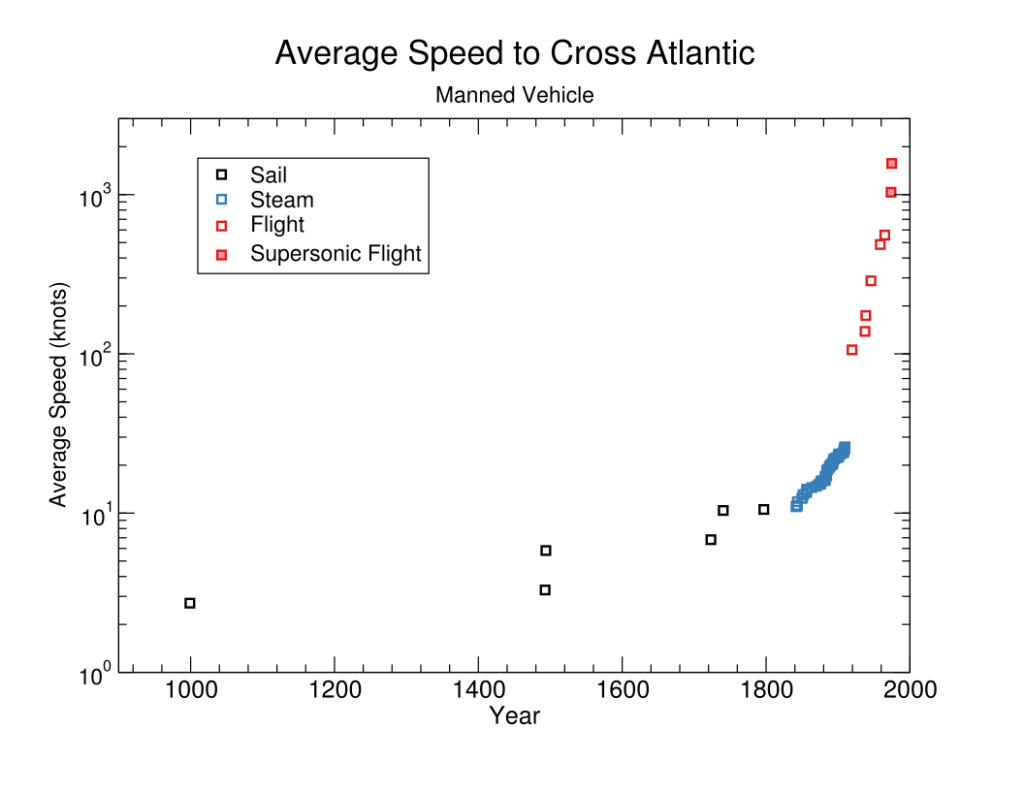
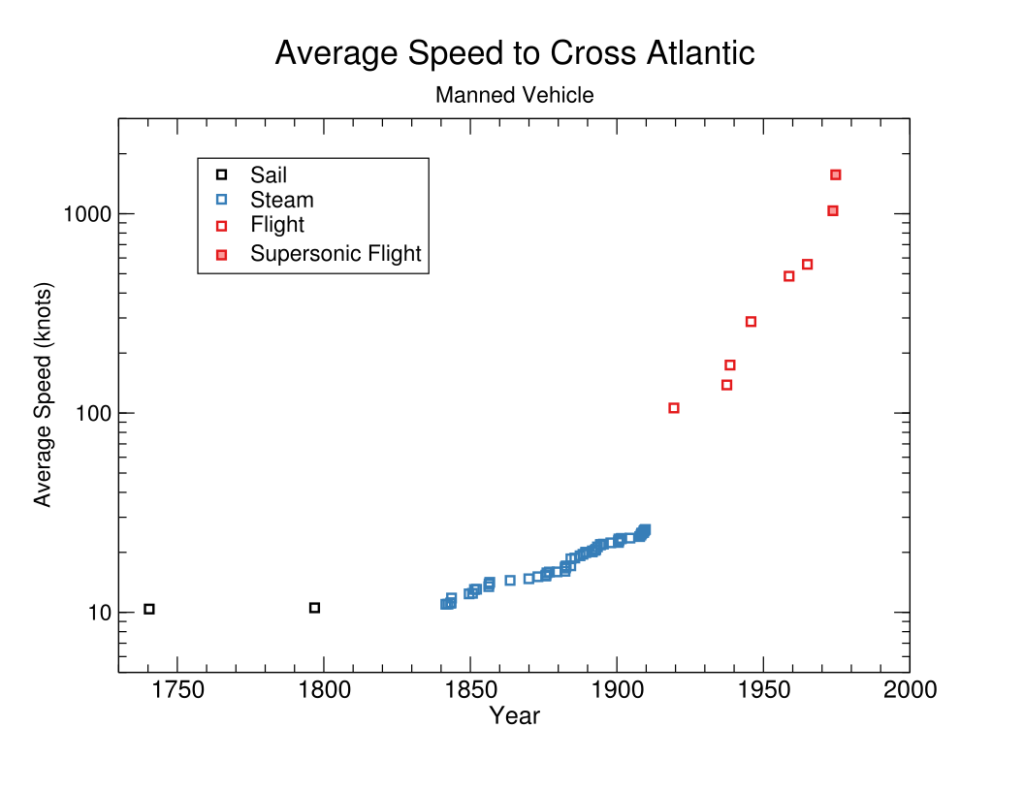
Transatlantic message speed
Main article: Historic trends in transatlantic message speed
The speed of delivering a short message across the Atlantic Ocean saw at least three discontinuities of more than ten years before 1929, all of which also were more than one thousand years: a 1465-year discontinuity from Columbus’ second voyage in 1493, a 2085-year discontinuity from the first telegraph cable in 1858, and then a 1335-year discontinuity from the second telegraph cable in 1866.

Long range military payload delivery
Main article: Historic trends in long range military payload delivery
The speed at which a military payload could cross the Atlantic ocean contained six greater than 10-year discontinuities in 1493 and between 1841 and 1957:
| Date | Mode of transport | Knots | Discontinuity size (years of progress at past rate) |
| 1493 | Columbus’ second voyage | 5.8 | 1465 |
| 1884 | Oregon | 18.6 | 10 |
| 1919 | WWI Bomber (first non-stop transatlantic flight) |
106 | 351 |
| 1938 | Focke-Wulf Fw 200 Condor | 174 | 19 |
| 1945 | Lockheed Constellation | 288 | 25 |
| 1957 | R-7 (ICBM) | ~10,000 | ~500 |

Bridge spans
Main article: Historic trends in bridge span length
We measure eight discontinuities of over ten years in the history of longest bridge spans, four of them of over one hundred years, five of them robust as to slight changes in trend extrapolation.
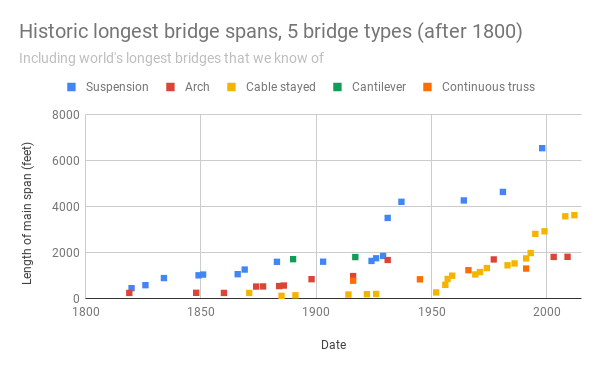
Light intensity
Main article: Historic trends in light intensity
Maximum light intensity of artificial light sources has discontinuously increased once that we know of: argon flashes represented roughly 1000 years of progress at past rates.
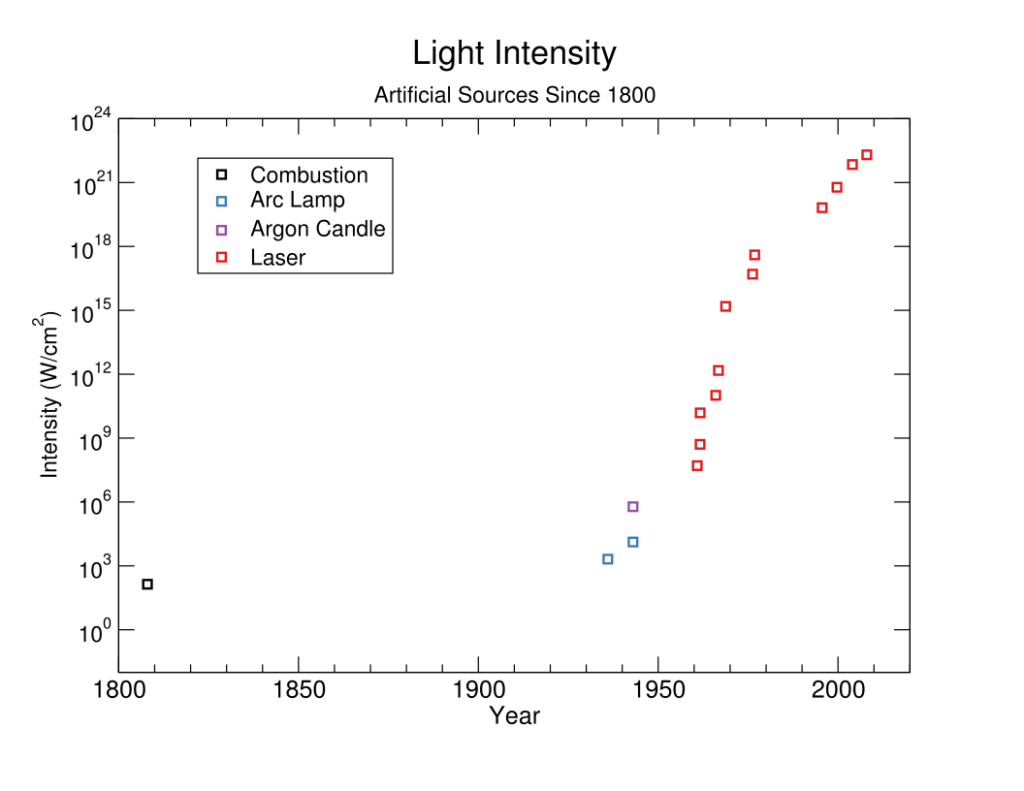
Book production
Main article: Historic trends in book production
The number of books produced in the previous hundred years, sampled every hundred or fifty years between 600AD to 1800AD contains five greater than 10-year discontinuities, four of them greater than 100 years. The last two follow the invention of the printing press in 1492.
The real price of books dropped precipitously following the invention of the printing press, but the longer term trend is sufficiently ambiguous that this may not represent a substantial discontinuity.
The rate of progress of book production changed shortly after the invention of the printing press, from a doubling time of 104 years to 43 years.
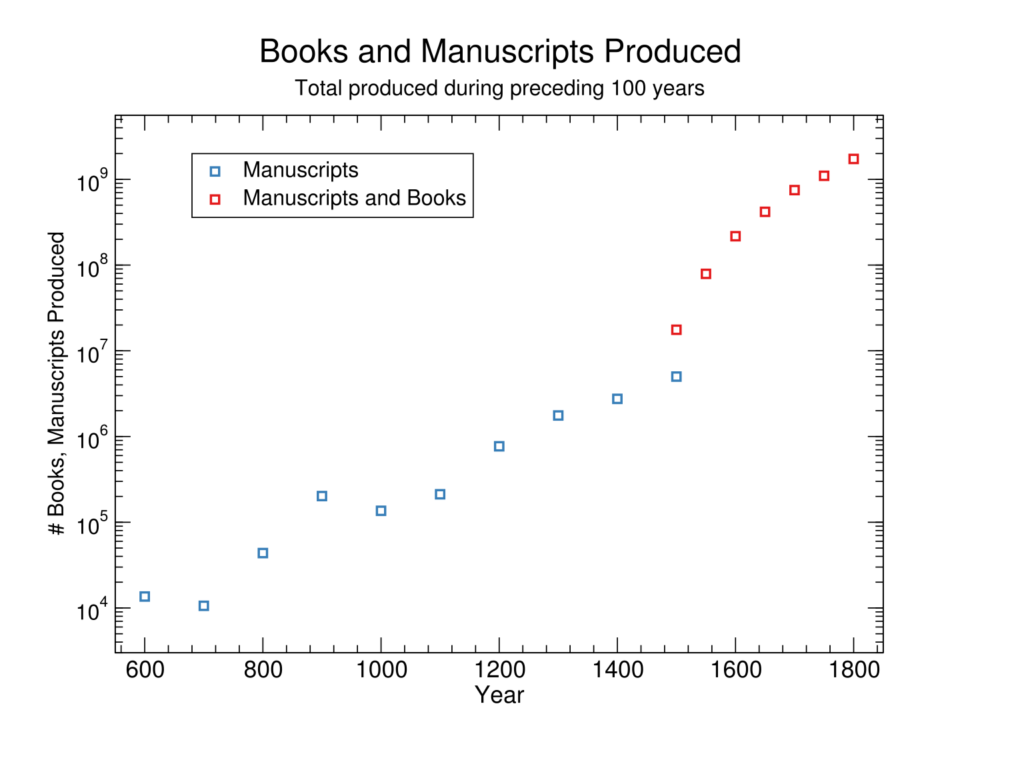
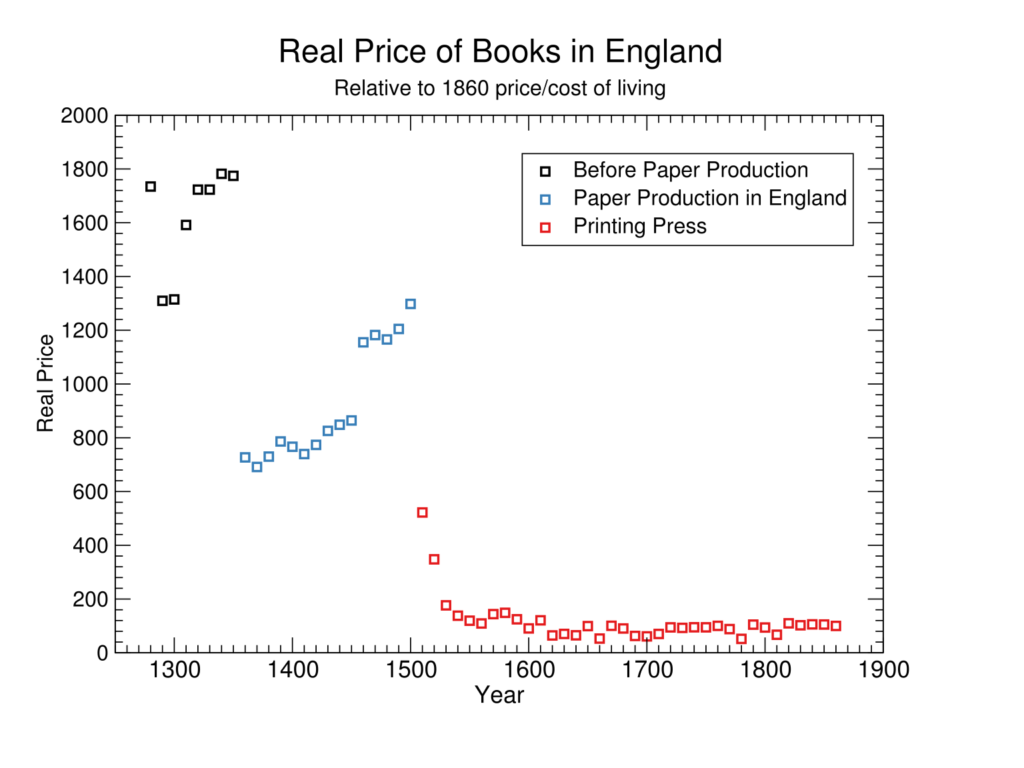
Telecommunications performance
Main article: Historic trends in telecommunications performance
There do not appear to have been any greater than 10-year discontinuities in telecommunications performance, measured as:
- bandwidth-distance product for all technologies 1840-2015
- bandwidth-distance product for optical fiber 1975-2000
- total bandwidth across the Atlantic 1956-2018
Radio does not seem likely to have represented a discontinuity in message speed.
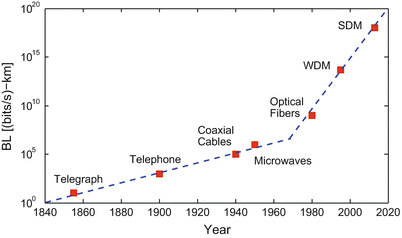
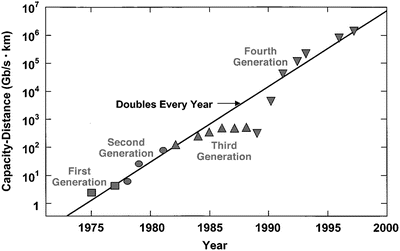
Bandwidth-distance product in fiber optics alone, from Agrawal, 20166 (Note: 1 Gb = 10^9 bits)
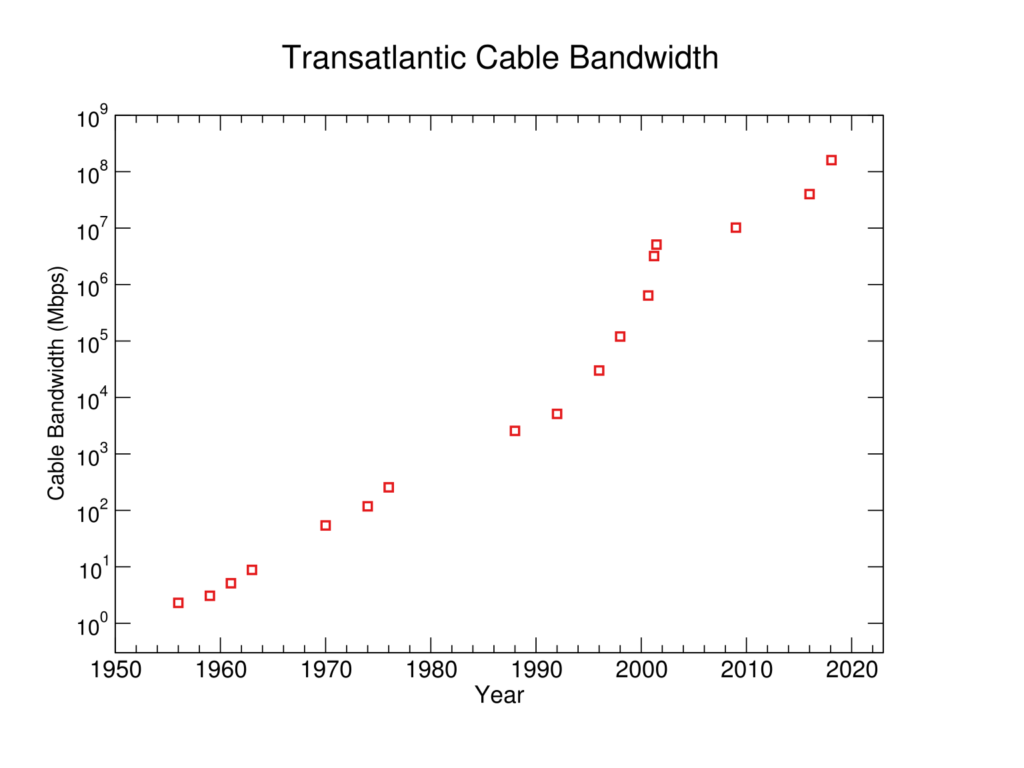
Cotton gins
Main article: Effect of Eli Whitney’s cotton gin on historic trends in cotton ginning
We estimate that Eli Whitney’s cotton gin represented a 10 to 25 year discontinuity in pounds of cotton ginned per person per day, in 1793. Two innovations in 1747 and 1788 look like discontinuities of over a thousand years each on this metric, but these could easily stem from our ignorance of such early developments. We tentatively doubt that Whitney’s gin represented a large discontinuity in the cost per value of cotton ginned, though it may have represented a moderate one.

Altitude
Main article: Historic trends in altitude
Altitude of objects attained by man-made means has seen six discontinuities of more than ten years of progress at previous rates since 1783, shown below.
| Year | Height (m) | Discontinuity (years) | Entity |
| 1784 | 4000 | 1032 | Balloon |
| 1803 | 7280 | 1693 | Balloon |
| 1918 | 42,300 | 227 | Paris gun |
| 1942 | 85,000 | 120 | V-2 Rocket |
| 1944 | 174,600 | 11 | V-2 Rocket |
| 1957 | 864,000,000 | 35 | Pellets (after one day) |

Slow light
Main article: Historic trends in slow light technology
Group index of light appears to have seen discontinuities of 22 years in 1995 from Coherent Population Trapping (CPT) and 37 years in 1999 from EIT (condensate). Pulse delay of light over a short distance may have had a large discontinuity in 1994 but our data is not good enough to judge. After 1994, pulse delay does not appear to have seen discontinuities of more than ten years.
Figure 12: Progress in pulse delay and group index. “Human speed” shows the rough scale of motion familiar to humans.
Particle accelerators
Main article: Historic trends in particle accelerator performance
None of particle energy, center-of-mass energy nor Lorentz factor achievable by particle accelerators appears to have undergone a discontinuity of more than ten years of progress at previous rates.
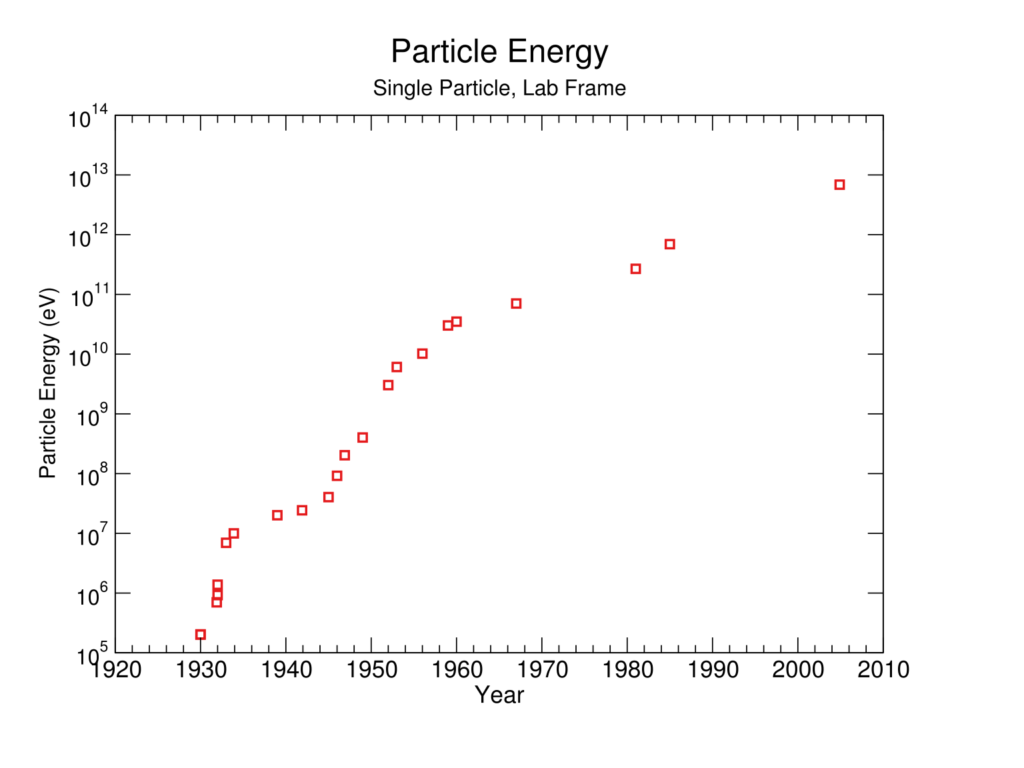
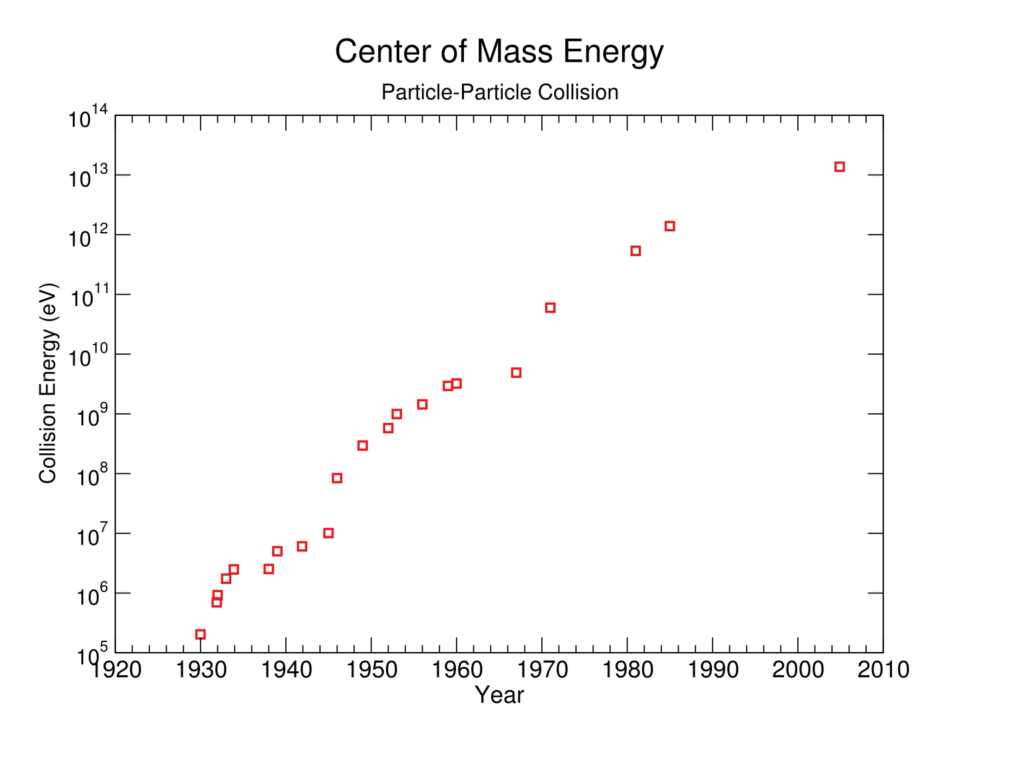

Penicillin on syphilis
Main article: Penicillin and historic syphilis trends
Penicillin did not precipitate a discontinuity of more than ten years in deaths from syphilis in the US. Nor were there other discontinuities in that trend between 1916 and 2015.
The number of syphilis cases in the US also saw steep decline but no substantial discontinuity between 1941 and 2008.
On brief investigation, the effectiveness of syphilis treatment and inclusive costs of syphilis treatment do not appear to have seen large discontinuities with penicillin, but we have not investigated either thoroughly enough to be confident.
Figure 14a: Syphilis—Reported Cases by Stage of Infection, United States, 1941–2009, according to the CDC7

Nuclear weapons
Main article: Effect of nuclear weapons on historic trends in explosives
Nuclear weapons constituted a ~7 thousand year discontinuity in energy released per weight of explosive (relative effectiveness).
Nuclear weapons do not appear to have clearly represented progress in the cost-effectiveness of explosives, though the evidence there is weak.
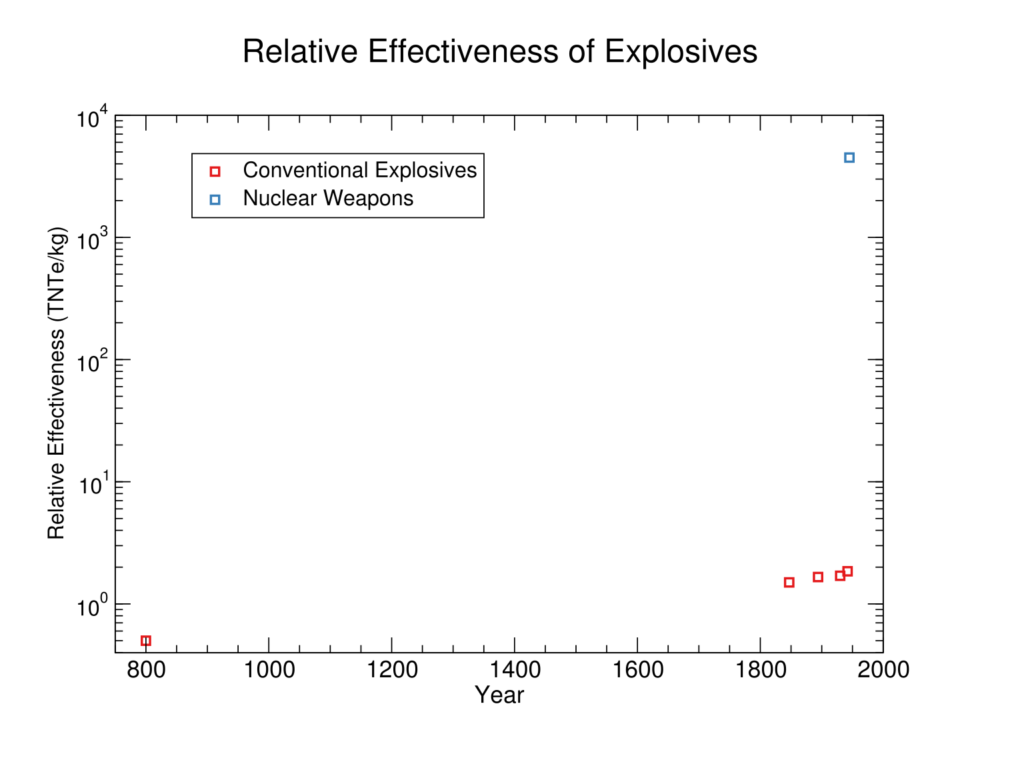
High temperature superconductors
Main article: Historic trends in the maximum superconducting temperature
The maximum superconducting temperature of any material up to 1993 contained four greater than 10-year discontinuities: A 14-year discontinuity with NbN in 1941, a 26-year discontinuity with LaBaCuO4 in 1986, a 140-year discontinuity with YBa2Cu3O7 in 1987, and a 10-year discontinuity with BiCaSrCu2O9 in 1987.
YBa2Cu3O7 superconductors seem to correspond to a marked change in the rate of progress of maximum superconducting temperature, from a rate of progress of .41 Kelvin per year to a rate of 5.7 Kelvin per year.
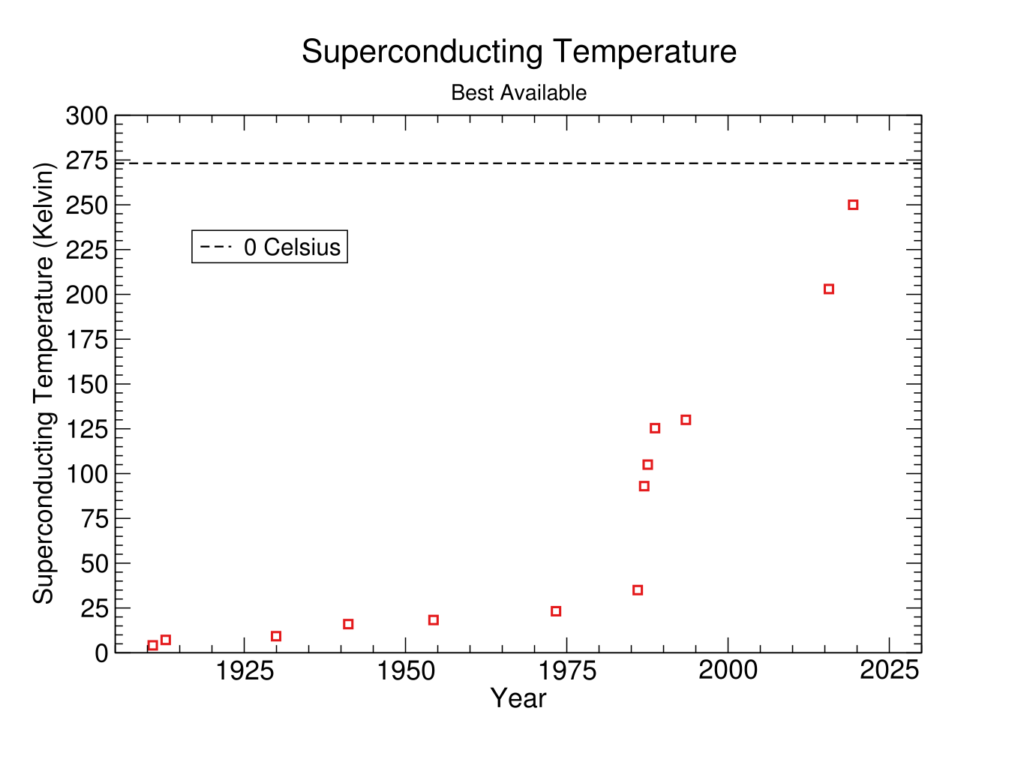
Land speed records
Main article: historic trends in land speed records
Land speed records did not see any greater-than-10-year discontinuities relative to linear progress across all records. Considered as several distinct linear trends it saw discontinuities of 12, 13, 25, and 13 years, the first two corresponding to early (but not first) jet-propelled vehicles.
The first jet-propelled vehicle just predated a marked change in the rate of progress of land speed records, from a recent 1.8 mph / year to 164 mph / year.
Chess AI
Main article: Historic trends in chess AI
The Elo rating of the best chess program measured by the Swedish Chess Computer Association did not contain any greater than 10-year discontinuities between 1984 and 2018.

Flight airspeed
Main article: Historic trends in flight airspeed records
Flight airspeed records between 1903 and 1976 contained one greater than 10-year discontinuity: a 19-year discontinuity corresponding to the Fairey Delta 2 flight in 1956.
The average annual growth in flight airspeed markedly increased with the Fairey Delta 2, from 16mph/year to 129mph/year.
Structure heights
Main article: Historic trends in structure heights
Trends for tallest ever structure heights, tallest ever freestanding structure heights, tallest existing freestanding structure heights, and tallest ever building heights have each seen 5-8 discontinuities of more than ten years. These are:
- Djoser and Meidum pyramids (~2600BC, >1000 year discontinuities in all structure trends)
- Three cathedrals that were shorter than the all-time record (Beauvais Cathedral in 1569, St Nikolai in 1874, and Rouen Cathedral in 1876, all >100 year discontinuities in current freestanding structure trend)
- Washington Monument (1884, >100 year discontinuity in both tallest ever structure trends, but not a notable discontinuity in existing structure trend)
- Eiffel Tower (1889, ~10,000 year discontinuity in both tallest ever structure trends, 54 year discontinuity in existing structure trend)
- Two early skyscrapers: the Singer Building and the Metropolitan Life Tower (1908 and 1909, each >300 year discontinuities in building height only)
- Empire State Building (1931, 19 years in all structure trends, 10 years in buildings trend)
- KVLY-TV mast (1963, 20 year discontinuity in tallest ever structure trend)
- Taipei 101 (2004, 13 year discontinuity in building height only)
- Burj Khalifa (2009, ~30 year discontinuity in both freestanding structure trends, 90 year discontinuity in building height trend)
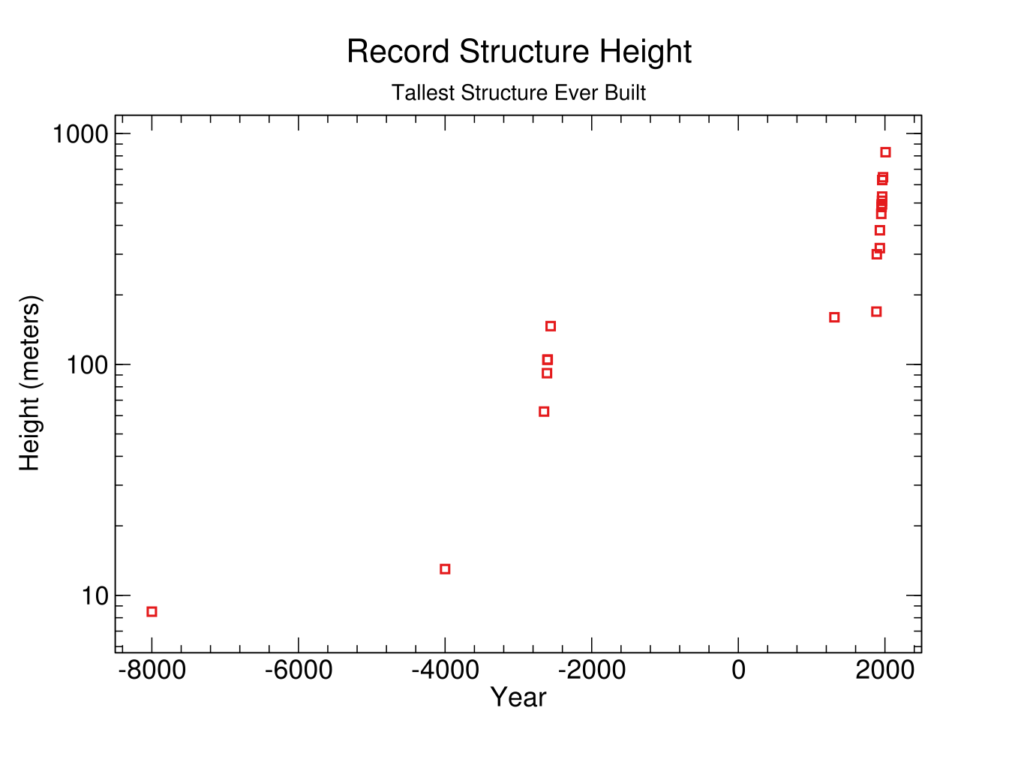
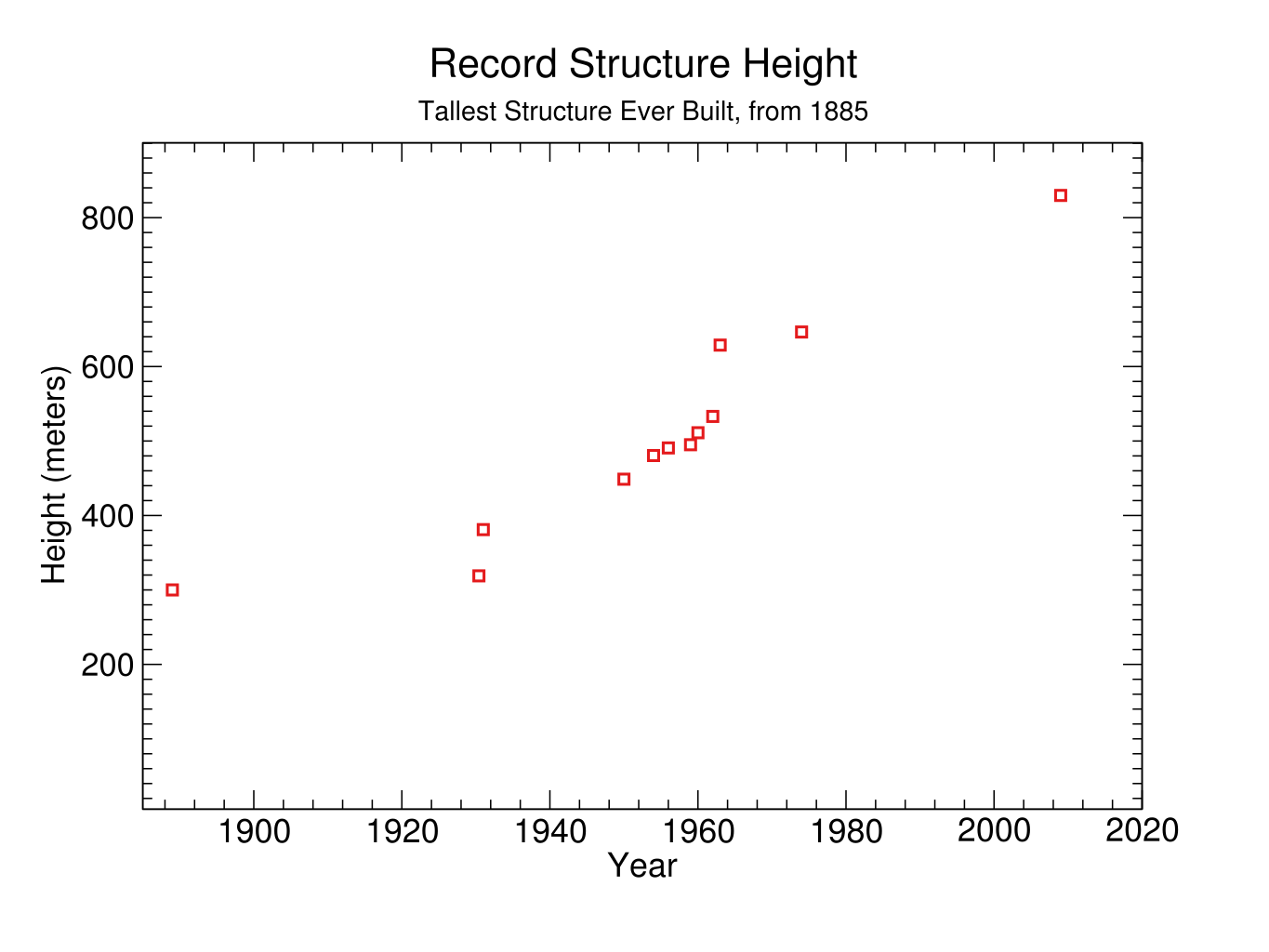

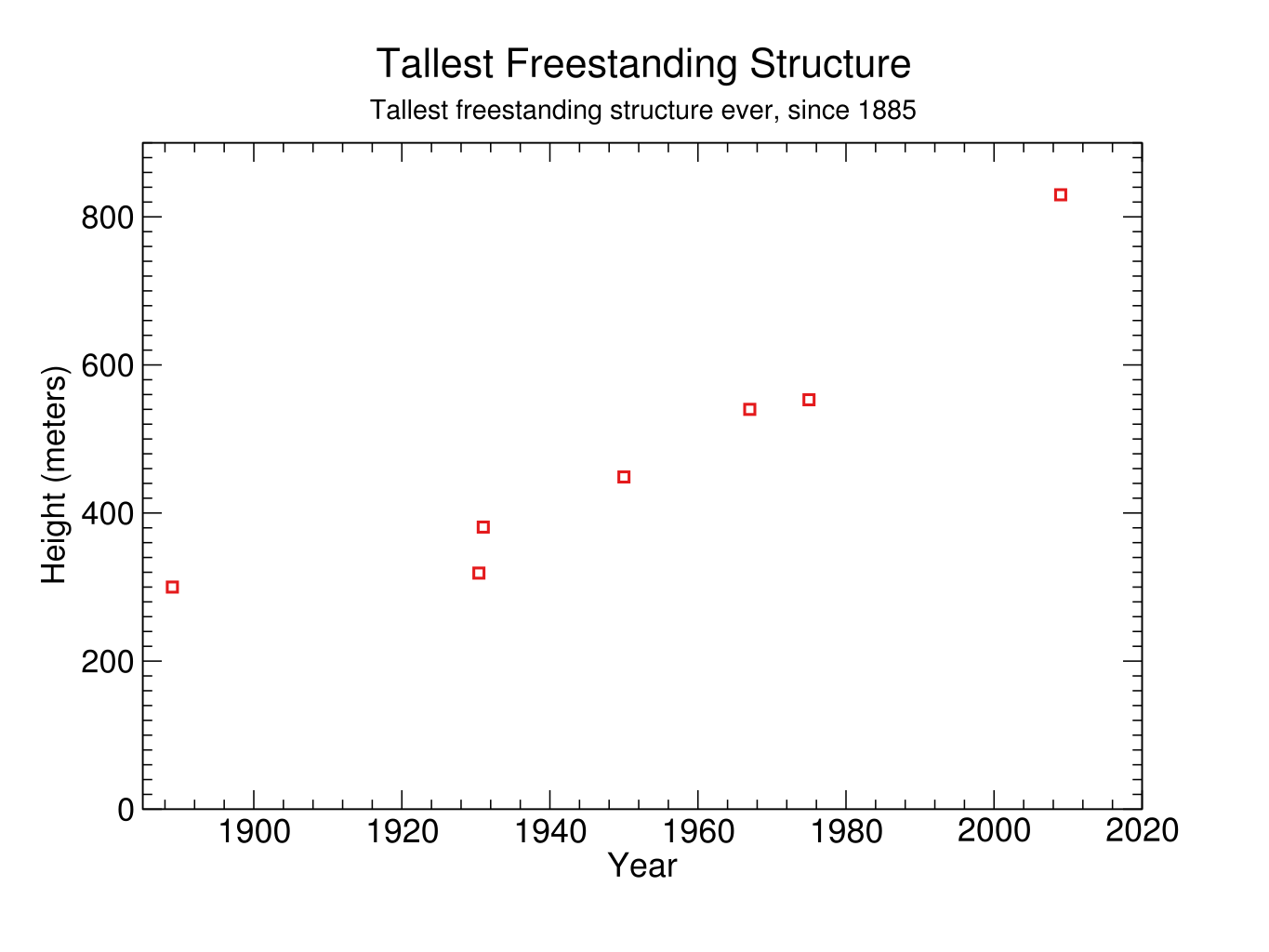

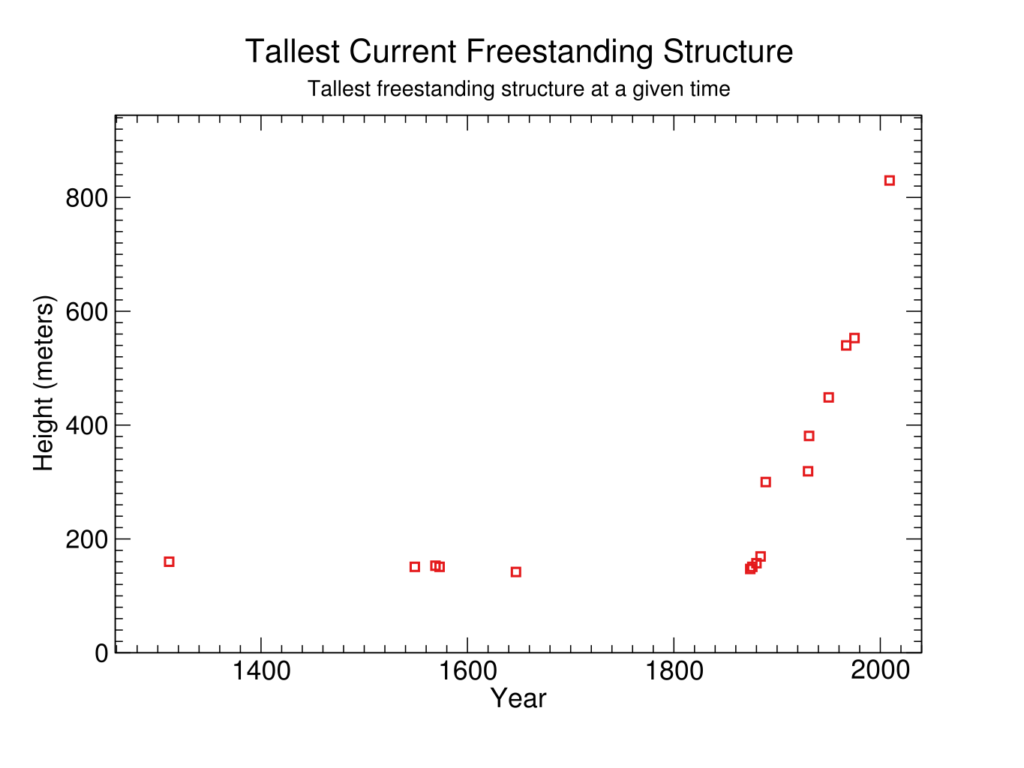
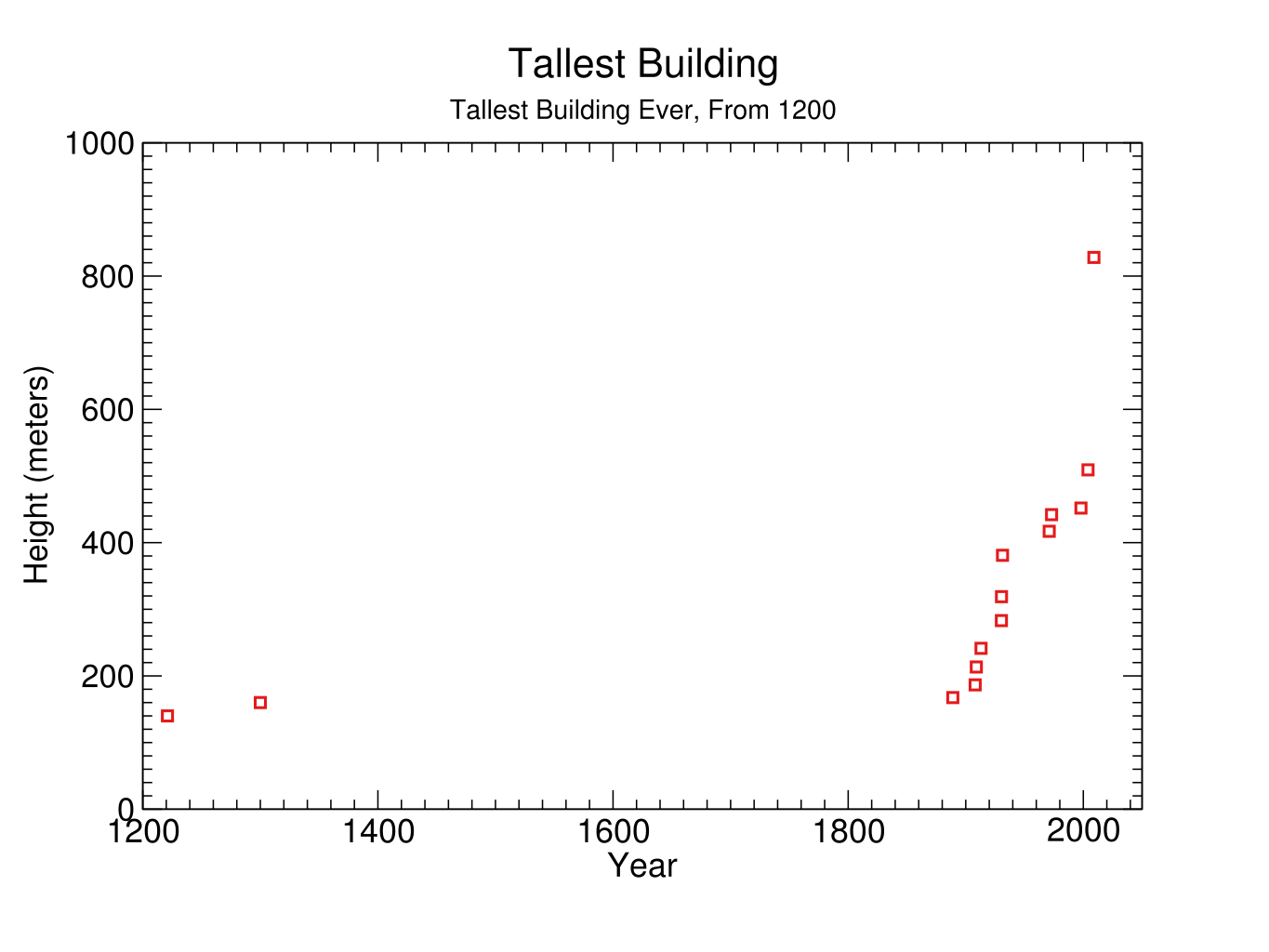

Breech loading rifles
Main article: Effects of breech loading rifles on historic trends in firearm progress
Breech loading rifles do not appear to have represented a discontinuity in firing rate of guns, since it appears that other guns had a similar firing rate already. It remains possible that breech loading rifles represent a discontinuity in another related metric.
Incomplete case studies
This is a list of cases we have partially investigated, but insufficiently to include in this page.
Extended observations
This spreadsheet contains summary data and statistics about the entire set of case studies, including all calculations for findings that follow.
Prevalence of discontinuities
- We investigated 38 trends in around 21 broad areas9
- Of the 38 trends that we investigated, we found 20 to contain at least one substantial discontinuity, and 15 to contain at least one large discontinuity. (Note that our trends were selected for being especially likely to contain discontinuities, so this is something like an upper bound on their frequency in trends in general. However some trends we investigated for fairly limited periods, so these may have contained more discontinuities than we found.)
- These discontinuities were produced by 63 distinct events, 29 of them producing large discontinuities.
- The robust large discontinuities were produced by 10 events
- 32% of trends we investigated saw at least one large, robust discontinuity (though note that trends were selected for being discontinuous, and were a very non-uniform collection of topics, so this could at best inform an upper bound on how likely an arbitrary trend is to have a large, robust discontinuity somewhere in a chunk of its history)
- 53% of trends saw any discontinuity (including smaller and non-robust ones), and in expectation a trend saw more than two of these discontinuities.
- Across all years of any metric we considered, the rate of discontinuities/year was around 0.02% (though note that this is heavily influenced by how often you consider thousands of years with poor data at the start).
Some fuller related data, from spreadsheet:
| All discontinuities | Large | Robust | Robust large | |
| Metrics checked | 38 | 38 | 38 | 38 |
| Discontinuity count | 88 | 39 | 20 | 14 |
| Trends exhibiting that type of discontinuity | 20 | 15 | 16 | 12 |
| Trends with 2+ discontinuities of that type | 14 | 10 | 4 | 2 |
| P(discontinuity|trend) | 0.53 | 0.39 | 0.42 | 0.32 |
| E(discontinuities per trend) | 2.3 | 1.0 | 0.5 | 0.4 |
| P(multiple discontinuities|trend) | 0.37 | 0.26 | 0.11 | 0.05 |
| P(multiple discontinuities|trend with at least one) | 0.70 | 0.67 | 0.25 | 0.17 |
| P(multiple discontinuities|trend with at least one, and enough search to find more) | 0.78 | 0.77 | 0.29 | 0.20 |
Nature of discontinuous metrics
We categorized each metric as one of:
- ‘technical’: to do with basic physical parameters (e.g. light intensity, particle energy in particle accelerators)
- ‘product’: to do with usable goods or services (e.g. cotton ginned per person per day, size of largest ships, height of tallest structures)
- ‘industry’: to do with an entire industry rather than individual items (e.g. total production of books)
- ‘societal’: to do with society at large (e.g. syphilis mortality)
We also categorized each metric as one of:
- ‘feature’: a characteristic that is good, but not close to encompassing the purpose of most related efforts (e.g. ship size, light intensity)
- ‘performance proxy’: approximates the purpose of the endeavor (e.g. cotton ginned per person per day, effectiveness of syphilis treatment)
- ‘value proxy’: approximates the all-things-considered value of the endeavor (e.g. real price of books, cost-effectiveness of explosives)
Most metrics fell into ‘product feature’ (16) ‘technical feature’ (8) or ‘product performance proxy’ (6), with the rest (8) spread across the categories.
Here is what these trends are like (from this spreadsheet):
| product feature | technical feature | product performance proxy | rare categories | |
| All discontinuities | ||||
| number of discontinuities | 73 | 8 | 2 | 5 |
| number of trends | 16 | 8 | 6 | 8 |
| number of trends with discontinuities | 13 | 4 | 2 | 1 |
| discontinuities per trend | 4.6 | 1.0 | 0.3 | 0.6 |
| fraction of trends with discontinuity | 0.81 | 0.50 | 0.33 | 0.13 |
| Large discontinuities | ||||
| number of large discontinuities | 32 | 3 | 0 | 4 |
| number of trends | 16 | 8 | 6 | 8 |
| number of trends with large discontinuities | 11 | 3 | 0 | 1 |
| large discontinuities per trend | 2.0 | 0.4 | 0.0 | 0.5 |
| fraction of trends with large discontinuity | 0.69 | 0.38 | 0.00 | 0.13 |
Primary authors: Katja Grace, Rick Korzekwa, Asya Bergal, Daniel Kokotajlo.
Thanks to many other researchers whose work contributed to this project.
Thanks to Stephen Jordan, Jesko Zimmermann, Bren Worth, Finan Adamson, and others for suggesting potential discontinuities for this project in response to our 2015 bounty, and to many others for suggesting potential discontinuities since, especially notably Nuño Sempere, who conducted a detailed independent investigation into discontinuities in ship size and time to circumnavigate the world11.
Notes
- For instance, if the development of advanced AI takes place in the context of a large discontinuity, then it is arguably more likely to involve large shifts in power, to take place sooner than predicted, to be surprising, to be disruptive, and to be dangerous. Also, our research should investigate questions such as how to prepare or be warned, rather than questions like when the present trajectories of AI progress will reach human-level capabilities. See likelihood of discontinuous progress around the development of AGI for more discussion.
- See this spreadsheet column for the judgments.
- Recall that our trends were selected for being especially likely to contain discontinuities, so this is something like an upper bound on their frequency in trends in general. However some trends we investigated for fairly limited periods, so these may have contained more discontinuities than we found.
- Agrawal, Govind P. 2016. “Optical Communication: Its History And Recent Progress”. Optics In Our Time, 177-199. Springer International Publishing. doi:10.1007/978-3-319-31903-2_8., https://link.springer.com/chapter/10.1007/978-3-319-31903-2_8
- Agrawal, Govind P. 2016. “Optical Communication: Its History And Recent Progress”. Optics In Our Time, 177-199. Springer International Publishing. doi:10.1007/978-3-319-31903-2_8., https://link.springer.com/chapter/10.1007/978-3-319-31903-2_8
- From Figure 33 in Division of STD Prevention, “Sexually Transmitted Disease Surveillance 2009,” November 2010, https://web.archive.org/web/20170120091355/https://www.cdc.gov/std/stats09/surv2009-Complete.pdf.
- See table 4D in Gregory L. Armstrong, Laura A. Conn, and Robert W. Pinner, “Trends in Infectious Disease Mortality in the United States During the 20th Century,” JAMA 281, no. 1 (January 6, 1999): 61–66, https://doi.org/10.1001/jama.281.1.61.
- Nuño Sempere. “Discontinuous Progress in Technological Trends.” Accessed March 8, 2021. https://nunosempere.github.io/rat/Discontinuous-Progress.html.

